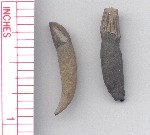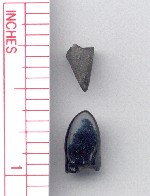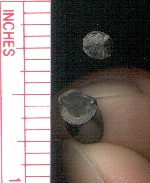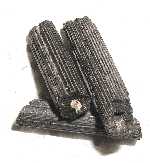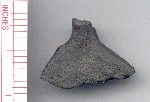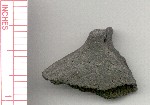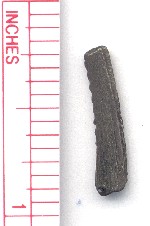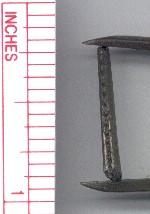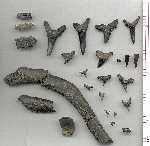This webpage requires a bit of reorganization and separation between the Eocene & Miocene faunas. Since new photographs will be required, it will be a while before this webpage is updated. But for now I have included corrections as suggested by E. Manning (Geology Dept., Tulane Univ., New Orleans).
New Jersey Shark Teeth and Associated Marine Fossils - Kirkwood Formation (Eocene & Miocene) from Monmouth County
An older, middle Eocene one, probably reworked from the Shark River Fm. into the basal Kirkwood Fm.; and a much later, middle Miocene one, which appears to post-date the early Miocene Kirkwood Fm. (it seems to be equivalent to the Calvert Fm. of Maryland, or the Pungo River Fm. of North Carolina). The overall impression you get of the middle Miocene fauna here is of a relatively deep water marine (perhaps of middle shelf depth, about 100 meters), with a mixture of shallow marine taxa (Myliobatis, Odontaspis, Pogonias, Bagre) and open-ocean forms (Isurus, Notorhynchus, Thunnus). The habitat was nutrient-rich, and the bottom well-oxygenated (it's often anoxic in very deep water). The Eocene fauna was probably a bit shallower (with the Abdounia and Trichiurus), but still including some deep water forms (Cylindracanthus and Otodus).
|



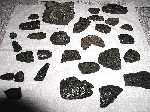
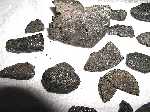
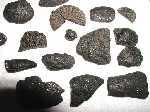 |
| MIOCENE: Bones from aquatic mammals or reptiles. The largest one is 4" long and probably from a porpoise. The round flat bone in the last photo (3/4 of the circle found) is a Epiphyses from a Porpoise Vertebra also known as a "Cookie".
|



|
| MIOCENE: Upper teeth of the Hemipristis Serra Agassiz (Snaggletooth shark). My favorite NJ shark teeth. Rare teeth. Their characteristic shape/design make them easily identifiable.
|
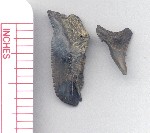
|
| MIOCENE: Carcharodon tooth frag. on the left, and an Hemipristis serra lw. lateral tooth on the right.
|

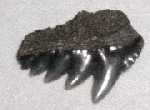

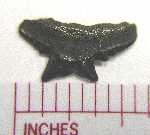
|
| MIOCENE: Lower teeth of the sevengill shark Notorhynchus cepedianus (Peron, 1807). Purdy, et al.(2001, p. 83) pointed out that the Miocene N. "primigenius" (Agassiz, 1843) is a junior synonym of the modern species of 7-gill. Note that in the 3rd photo from the left, the tooth on the right is an Odontaspis. The symphyseal tooth on the far right is a lower sympyseal of Galeocerdo, not Notorhynchus cepedianus upper teeth are much smaller and simpler, with fewer cusps. The Notorhynchus cepedianus are rare teeth, even rarer to find them intact.
|
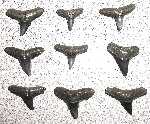 |
|
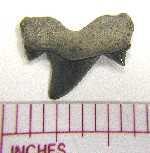
|
|
MIOCENE: The photo of the supposed lemon shark Negaprion eurybathrodon (Blake, 1862) [Purdy, et al.(2001, p. 156) suggest that the modern lemon shark N. brevirostris (Poey, 1868) is a junior synonym of the fossil species] likely includes lower teeth of the reef shark Carcharhinus. The tooth in the 2nd row, on the right, is definitely an up. lat. tooth of Carcharhinus sp. In Florida, the various species of Carcharhinus (bull shark, Galapagos shark, black tip, white tip, sandbar shark, etc.) generally are the most common shark genus in the fauna. I see no definite evidence here of the m. Eocene C. gibbesi gilmorei (Leriche, 1942). Common teeth, note that these teeth tend to have there roots covered/replaced with pyrite.
|
|
EOCENE: Otodus Appendiculatus Agassiz (a member of the mackerel shark family, the species is often called "Cretolamna") teeth are anothor of my favorite teeth to collect. A rugged little tooth with well pronounced cusplets - typically one on each side. These teeth are not usually found any larger than 1/2 inch. Several advanced lamnid sharks evolved from this type of shark, including the great white.
|
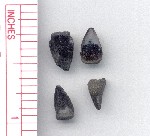 |
|

|
|
EOCENE: Scomberomorus sp. (called "Cybium" in the earlier literature) or Mackerel (a boney fish) teeth. Rare. NOTE: The tooth in the 2nd row, at the right, is another bony fish tooth but not Scomberomorus
|
|
EOCENE: Anterior teeth of the cutlassfish Trichiurus sp. (sometimes called "Trichiurides") teeth. Rare.
|
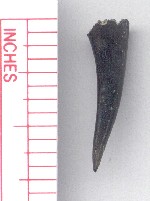
 |
|
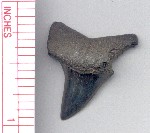
|
|
EOCENE: A possible (barbless) lateral tooth of Trichiurus sp.
|
|
The Isurus "desori" (Mako shark) looks like an upper lateral of I. hastalis (Agassiz, 1838). As Purdy, et al. (2001, p. 114) note, the types of the Miocene O. desori Agassiz, 1843 are teeth of the modern shortfin mako I. oxyrinchus Rafinesque, 1810. Their upper teeth are much narrower than in I. hastalis. Very rare.
|
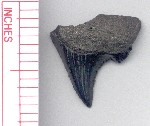


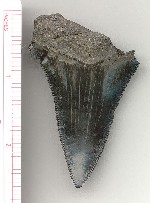

|
| MIOCENE: Carcharodon subauiculatus Agassiz, 1839 (Purdy, et al., 2001, p. 128). An upper post. (left) and an upper anterior (right). (Great White shark). Very rare.
|
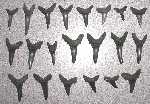


|
| MIOCENE: The common teeth found in this area are the lower teeth of the sand tiger Odontaspis cuspidatus (Agassiz, 1843) (today often placed with "Carcharias"). Some comments on upper and lower shark teeth - the lowers often have U-shaped roots, with a high lingual knob in the middle, while the uppers have straighter, flatter roots; the primary cusp is generally narrower in lowers than uppers (as in most of those in the bottom row, and those in the photos marked O. cuspidatus); and accessory cusps are generally better developed in upper than lower teeth. In the photo on the right, the tooth frag. on the rt. is of an up. tooth of Carcharodon subauriculatus, not Odontaspis. The partial root on the right is one inch in length, the whole tooth could have been 4" long.
|
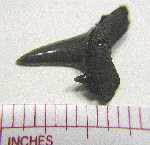
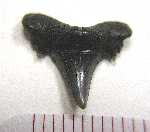
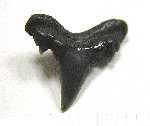
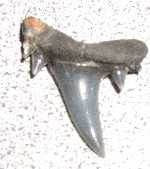
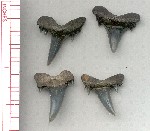
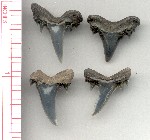
|
| MIOCENE: Odontaspis cuspidata (Sand tiger shark). Their characteristic 4 or more side cusplets make them easily identifiable.
|
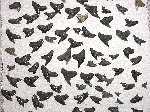
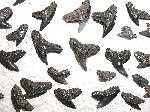
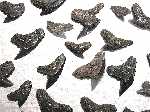
|
| MIOCENE: The common teeth found in this area are the lower teeth of Galeocerdo aduncus Agassiz, 1843. The narrower primary cusp, and more arched root with high central knob are just features of lower teeth (as in the two teeth in the "Unknown" photo at left). The problem came up because, in the modern tiger shark G. cuvier (Lesueur, 1822), the lower teeth have broadened and flattened, so that they resemble the upper teeth (to emphasize cutting over holding). The teeth of the typical middle Eocene tiger shark, G. latidens (Agassiz, 1843) look rather different from these teeth. The change to the modern-type teeth took place in the late Miocene, so it helps date the Miocene fauna.
|

|
| EOCENE & MIOCENE: Myliobatis (Eagle ray, median pavement teeth). Common teeth, note that some of these teeth tend to be covered/replaced with pyrite.
|

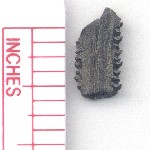
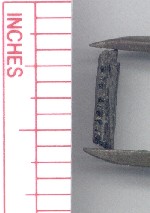
|
| EOCENE or MIOCENE: Myliobatis (Eagle ray) tail spine fragment. Very rare.
|

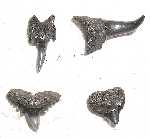
 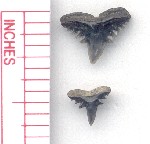 |
| EOCCENE: Lower left corner of the 2nd photo, and all of the 3rd and 4th, the two teeth shown are Abdounia recticona claibornensis (White, 1956), originally described from the late middle Eocene Gosport Fm. of SW Alabama, and now known across the Gulf Coastal Plain. Its occurence suggests that the Shark R. Fm. is of late middle Eocene (M. Bartonian) age, equivalent to the Cockfield Fm. of Tex. & La. and the Gosport Fm. of Alabama, both of the uppermost Claiborne Grp. It can be distinguished from the typical A. r. recticona (Winkler, 1873), from the early-middle Eocene of England, by having more than 3 accessory cusp on each heel, though they almost certainly intergrade (which is okay for subspecies). In the 3rd and 4th photos, the tooth at the top is an upper lateral, while the bottom one is a lower lateral (as in Fowler, 1911, fig. 37, p. 78).
|
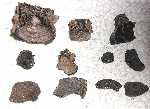
|
| Vertebra from shark, rays, and fish.
|




 |
| Vertebra from shark, reptile, and fish. Gastropods. Pyritized bone and wood. In the five mixed shark/reptile/fish/snail/wood photos, one specimen is certainly Eocene. It's the vertebra 2nd from the left in the top row, and it should be shown separately from the others which are Miocene. It's a partial vertebra (missing the neural arch) of the giant sea snake Palaeophis littoralis Cope, 1868 (P. holidanus & P. grandis are likely junior synonyms). These boa-related (the venomous modern sea snakes are cobra-related) giant sea snakes died out at the end of the Eocene. The elasmobranch vertebral centrum to its right appears to be of the sawfish Pristis (they typically have no holes around the periphery). In the photo, the middle one in the top row is from a ray, the bottom row (and the one at far right in the 2nd row) is shark vertebral centrum frags., and the others are all bony fish.
|
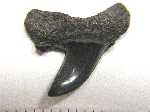
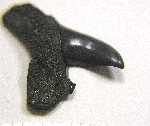
 |
| Pathological teeth are more usually called dental anomalies, and occur when the area deep in the jaw, where new teeth form (the "tooth germ"), is damaged (as by biting down hard on a catfish spine - yeowww). All succeeding teeth from that germ are malformed.
|
























































